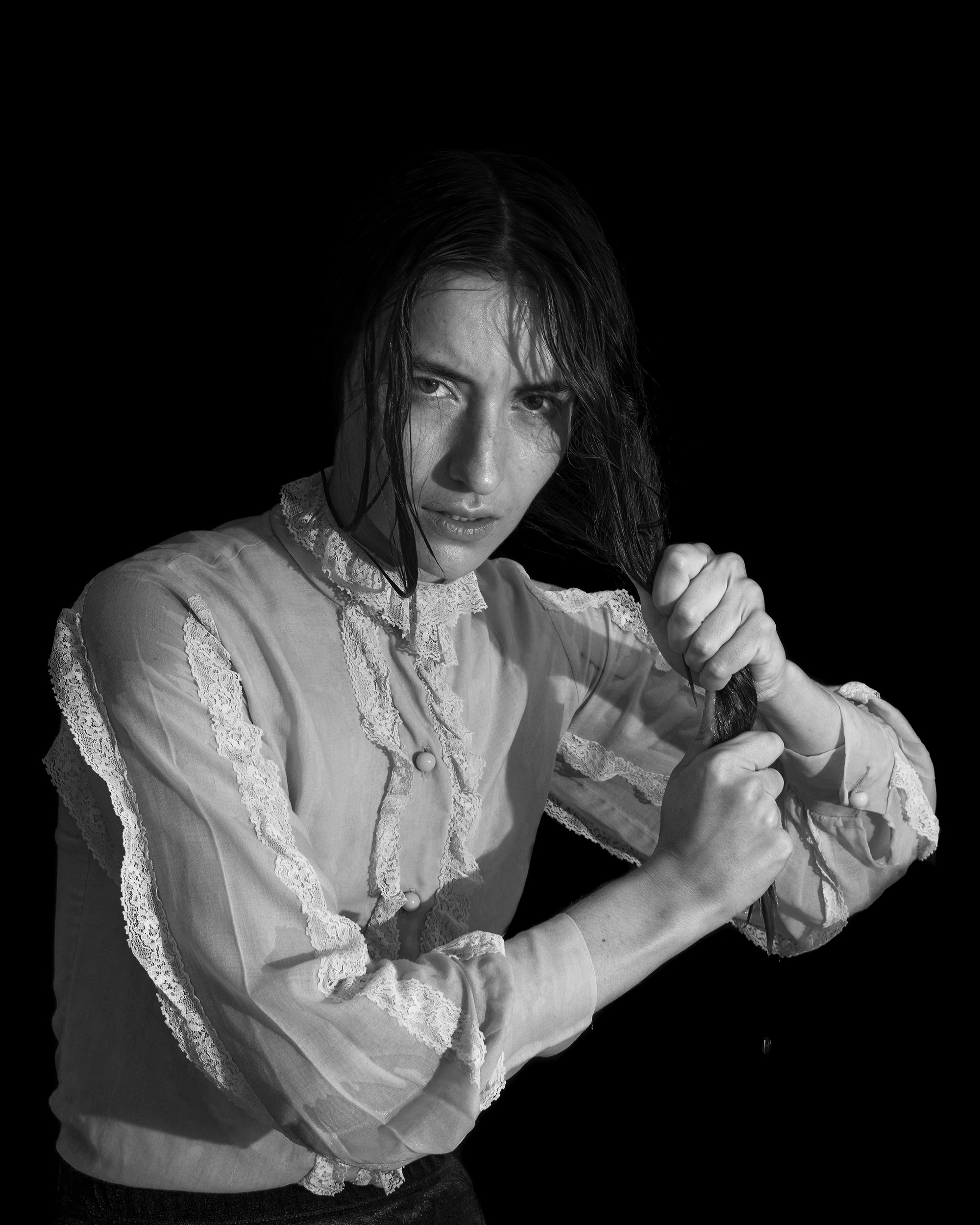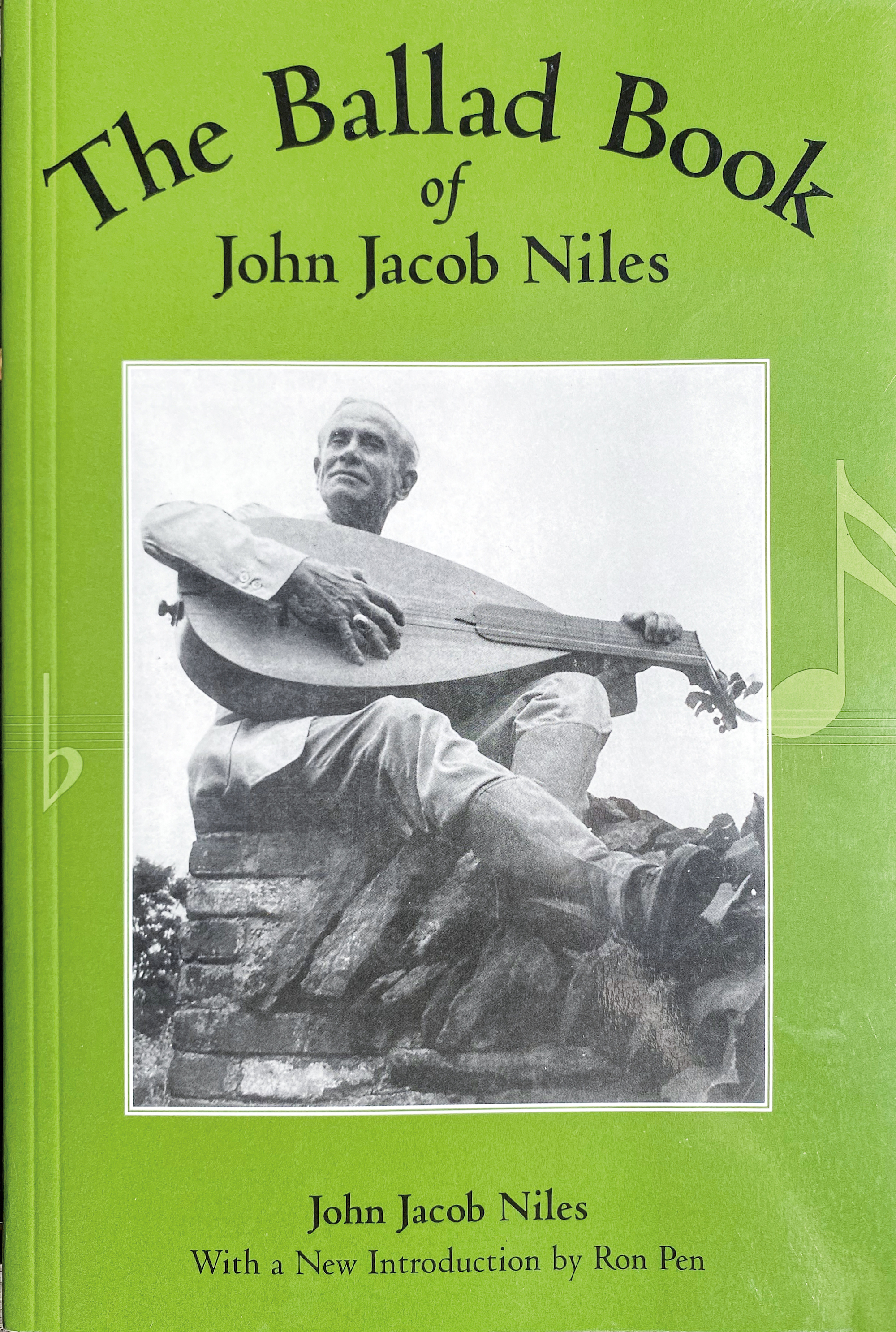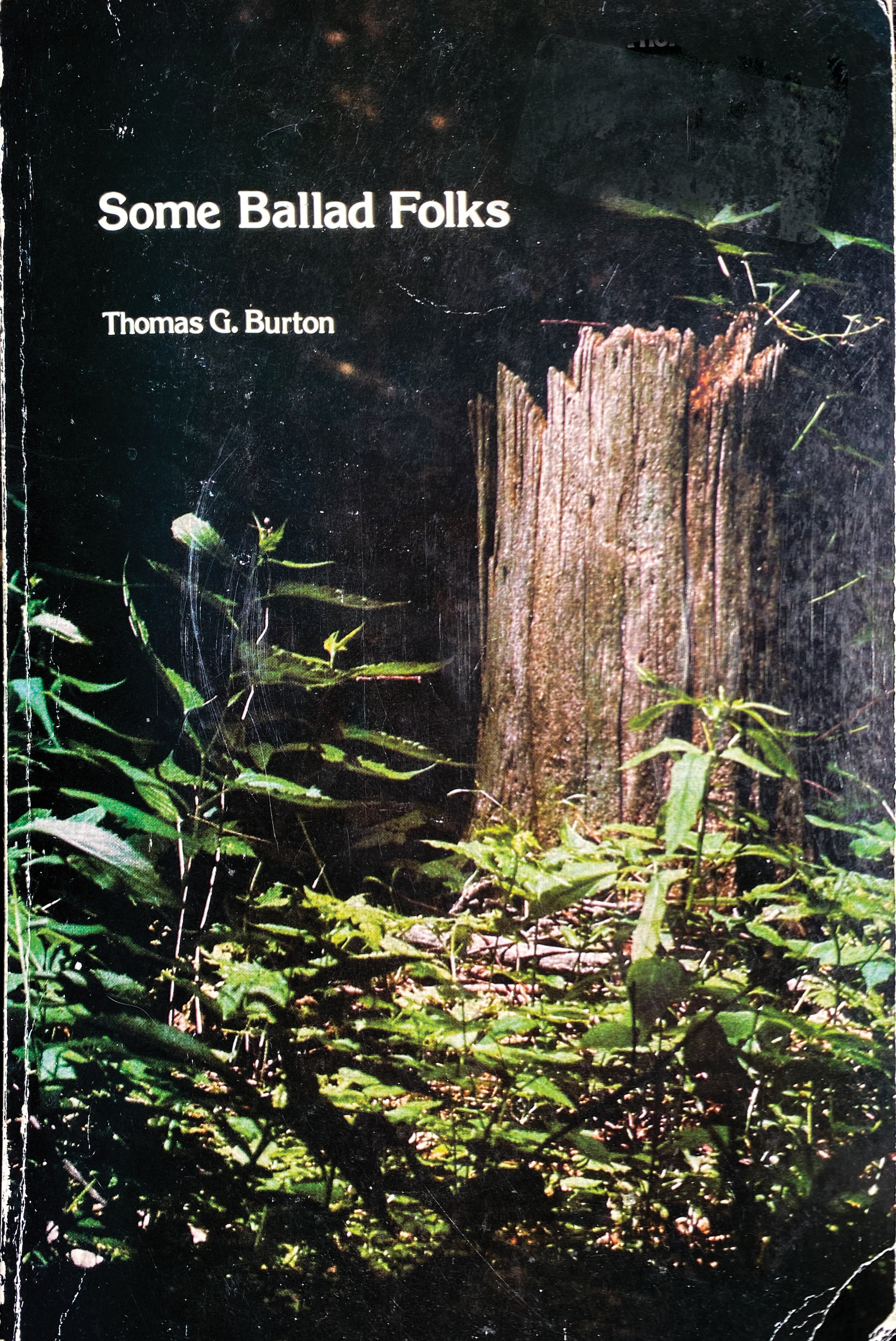Some Ballad Folks
By Justin Taylor

Knoxville Girl, 2016, a photo by Kristine Potter from her monograph Dark Waters, published in July by Aperture © The artist. Courtesy Sasha Wolf Projects
I’m a millennial Jew from suburban Miami. My parents are New York expats and their parents were mostly immigrants or first-gens who grew up speaking Yiddish. Outside of Hebrew prayers, my family’s conception of “traditional” music started with the Woodstock soundtrack and ended with Billy Joel. So my introduction to American roots music was inevitably going to come from either Bob Dylan or the Grateful Dead; as it happened, the Dead got there first. It would have been 1998, circa age sixteen, when I first encountered the word “Traditional” as a songwriting credit in the liner notes of Reckoning—a compilation of acoustic performances from the Grateful Dead’s fall 1980 tour—which featured “Jack-a-roe,” “Deep Elem Blues,” and “On the Road Again,” alongside their usual mélange of covers and originals. And, in a different essay on a different day I would go long on the Dead’s relationship to the American canon—the one they drew from as well as the one they gave us—but for now let it suffice to say that I wanted to hear what the Dead had heard, so I started tracking down their sources, and then their sources’ sources, and it was the strangest music I’d ever encountered, certainly not part of any “tradition” I recognized: It wasn’t classic rock, it wasn’t hip-hop, and it wasn’t the Macarena. This music sounded like it came from the fucking moon. But, as the contemporary folksinger Robbie Fulks aptly put it: “‘Stagger Lee’ would sound good on the moon, you don’t need a cane chair and a hound dog.”
With the aid of my Best Buy employee discount, helpful Deadheads on AOL forums, those old 12-for-a-dollar mail-order music clubs, and (eventually) the high-speed internet connection in my first college dorm, I came to know and revere the music of Doc Watson, Ralph Stanley, Roscoe Holcomb, Jean Ritchie, the Harry Smith Anthology of American Folk Music, the New Lost City Ramblers, Reverend Gary Davis, Woody Guthrie, and so many more. I developed a love of American roots music—bluegrass, blues, country, gospel—in its own right, with a particular interest in the ballad tradition. Because I was an aspiring writer, I read as well as listened: Francis J. Child’s foundational, multi-volume English and Scottish Popular Ballads; The Ballad Book of John Jacob Niles; Greil Marcus’s Invisible Republic: Bob Dylan’s Basement Tapes; David Dodd’s The Complete Annotated Grateful Dead Lyrics (an MA in American Studies all on its own), and whatever else I could get my hands on, including—at some point—Some Ballad Folks by Thomas G. Burton, published in 1978 by the Center for Appalachian Studies and Services at East Tennessee State University in Johnson City.
It’s a slender volume, paperback, hardly one hundred pages. The book presents five brief personal sketches of female ballad singers—Rena Hicks, Buna Hicks, Hattie Presnell, Lena Harmon, and Bertha Baird—all living on Beech Mountain, North Carolina, which is just over forty miles east of Johnson City, Tennessee. The relative isolation of Beech Mountain made it a rich reservoir of traditional ballads and tales, many traceable back to seventeenth-century England and Scotland—some are older yet, though sooner or later the trail of definitive provenance always disappears into the mists of history.
Their ages ranged from seventy to ninety-seven, and they had all lived most of their lives on Beech Mountain. The profiles are supplemented by a “Ballad Box” of lyrics and musical transcription for the ballads under discussion. Black-and-white photographs of the subjects and their homes are peppered throughout. The cover image, which bleeds across the front and back, is a photograph of a broken tree stump and some low greenery flashbulb-lit against an impenetrable black backdrop that I take to be the forest at night. At some point my copy must have spent a long time on a shelf in partial sunlight, because half of its pages have yellowed. The spine is badly creased, its glue dried and cracking, but so far no leaves have been lost.
I’m not sure where it came from or how long it has been on my shelf—fifteen years at least, maybe twenty. I thought an old friend had given it to me as a gift, but I called her and she said she didn’t know what I was talking about. Maybe I found it myself, chanced upon it in a bookstore or a library sale or in one of those giveaway boxes professors sometimes leave outside their office doors. I’ll probably never know, and in the end, it doesn’t matter, because the facts of how and when it came into my life are ultimately of far less interest than the fact that it’s still a part of my life, that I’ve got it open in front of me again.
At eighty-eight years old, Tom Burton is older than most of his subjects were when he interviewed them. He’s emeritus from ETSU but still an active scholar and documentarian. I emailed him through his website and a few days later we spoke on the phone. He seemed equally pleased and surprised at my interest in Some Ballad Folks, an obscure volume of admittedly niche interest. (For a neophyte, there are far better places to start, including Burton’s own Folksongs and Folksongs II.) Still, he gamely talked me through its genesis.
Burton’s interest in ballads took hold while he was an undergraduate at Lipscomb University in Nashville in the 1950s. He’d had a chance to take a class at Vanderbilt, with the eminent poet and scholar (and, alas, notorious segregationist) Donald Davidson, for whom he wrote a paper comparing roughly one hundred variants of “Lord Randall” (Child No. 12). This led to graduate work at Vandy, where Burton took a PhD in English in 1966. He taught at ETSU for his entire career, and though his scholarship is rooted in field collection, and documentary in nature, it was all carried out under the aegis of the English department. “This is English literature,” he told me, his voice crackling with conviction, as though I’d suggested otherwise. (I hadn’t, but plenty of people have over the generations, so the reflexive ire is understandable.) He believes that at least some of the original authors would have been aware of (or part of) the poetic traditions of the Renaissance. “They were very sophisticated. There’s some really good poetry that somebody who’s really good must have written.”
For most of the history of ballad collection, it was standard practice to ignore the stories of the people whose ballads one collected. Few collectors noted their subjects’ names for posterity, let alone their biographies or opinions. Many, including Child, didn’t even describe the tunes of the songs! Lyrics—especially variant versions of the same song—were the only thing that mattered to these colonialist poindexters, who methodically converted centuries of vibrant oral tradition into thousands of dusty, silent pages of dead text. (Pages I have read and loved, mind you, but even so.) In the course of this destructive perseveration, the singers were reduced to passive vessels of transmission, the flesh equivalent of tombs to be raided so their contents might be boxed up and hustled off to some museum.
By 1970, Burton had published three anthologies of regional folklore and songs. His interest shifted from the songs to the singers: Who taught you this one? What do you like about it? What does it mean to you? “Mountain folks…are done an injustice if they are viewed in either a romanticized or a brutalized manner,” Burton writes in Some Ballad Folks. To me he said, “It was an important thing not just to have the songs themselves. The implications of the language, the music—that wasn’t enough. I wanted to introduce their relationship to it, their understanding.”

Rena Hicks calls them “old people’s songs,” because old people taught them to her when she was young. “It’s the words; it ain’t the tune,” she says. “The feeling of the song, the feeling of the people that was in that place when the songs was made, even if it was death or life.” Hattie Presnell doesn’t discount the music: “All the old ones has got a lonesomer, you know, it’s got a lonesomer tune to it than the new ones do.” “To me I have a picture in my mind, a very vivid picture of it all,” says Lena Harmon. “And all my life I could create that scene.” Bertha Baird says, “I always sung just like I learnt ’em.” Buna Hicks—who is Rena’s aunt and Hattie’s mother—says, “They have new songs and they’re right pretty—some of them is—but I still hold to the old songs. Somehow or ’nother, they have a meaning to them; just like to hold them and keep ’em in memory.”
Every ballad is a folksong, but not every folksong is a ballad. (Of the three Traditionals on Reckoning, only “Jack-a-roe” qualifies.) Ballads, as the term is defined in the context of the folk tradition, are story songs. Their major themes—love, work, death, salvation, cross-dressing—are ageless, and therefore easily legible to a contemporary listener, even as their psychologies are bracingly opaque. Ballad characters inhabit worlds without subtext, perhaps without self-awareness, at least in our post-Freudian sense of the term. People are what they do or what is done to them. Plots develop according to the just-so logic of Greek myths and Japanese RPGs. Some ballads are clearly intended to reinforce the morality of school and church. Others revel in the sex, violence, and absurdity they depict, even if a finger-wagging final stanza is tacked on for plausible deniability. The best ballads are powerfully ambivalent, endlessly interpretable yet impossible to pin down.
They have simple, hypnotic tunes and recursive verse structures that serve as aide-mémoire for singers who would have known dozens, maybe hundreds, of them by heart. Ballads sound good paired with dulcimer, guitar, or banjo but sound best sung unaccompanied. They tell of romance and betrayal, cowardice and honor, justice and vengeance, faith and heresy, marriage and murder, lords and ladies, ghosts and demons, fortunes lost and won. Some seem to be based on real historical events or local legends, but the histories and localities in question are often as irretrievably lost as the original composers. Ballads have been passed through so many voices over so many generations that they can only be called authorless, at once everyone’s and no one’s.
The text of a given ballad doesn’t tend to vary much from singer to singer in Some Ballad Folks, but the women’s interpretations of it—its meaning to them—often do. “I feel it’s mighty sad,” Bertha Baird says of the female protagonist of “House Carpenter” (Child No. 243), who leaves her family to sail away with an old flame. “I think she ort to been just smacked all over for leavin’ her husband and baby.” Hattie Presnell thinks the woman’s real trouble was a lack of faith in love itself. “There’s where she would ’a’ made a mistake, lovin’ one and marryin’ another’n. Cause she had loved him before he went off, and when he come back to get her, she’d done a-married.” When the ship sinks, dooming the lovers, she sees God’s judgment handed down.
Lena Harmon’s father wouldn’t sing the most explicit parts of the ballads he knew, so his bowdlerized versions became hers. She complains that Doc Watson’s version of the adultery-and-murder ballad “Little Musgrave and Lady Barnard” (Child No. 81; recorded by Watson as “Matty Groves”) “brings in indecent things that I don’t like,” such as the foot page telling his lord, “Little Matty Groves is in bed with your wife and their hearts both beat as one.” Rena Hicks includes the explicit consummation of the affair in her version (most versions do), but Harmon’s prim rendition is all the more interesting in light of her sympathetic, even progressive take on Lady Barnard: “I’d say they were both in love with her and she wasn’t the wife of either one.”
Buna Hicks advises, “It pays anybody to sing a little bit slow if you can and get the understandin’ of these words, what they mean; they mean a lot sometimes.” Still, some things are hard to understand. “Jobal Hunter,” better known as “Sir Lionel” (Child No. 18), is a truly eerie ballad from the late medieval period about hunting a wild boar. Lionel is a figure of Arthurian legend, foster child of the Lady of the Lake, sidekick of Lancelot; Edward III, who ruled England from 1327 to 1377, was a big fan. Buna likely would not have known any of this. Her version doesn’t even name Lionel. In a way this is fitting, since the boar hunt is itself a folk archetype far older than Arthurian legend, and it’s likely that Lionel was swapped in as protagonist later on, possibly because of Edward’s known affection for him. We’ll never know. The song unfolds in a litany of oblique couplets such as “He met the witch wife on the bridge; blow your horn, Center / They fit three hours by the day, if you are the jobal hunter.” The witch wife is incidental to the main action, and doesn’t appear in many versions, but she had the strongest claim on Buna’s interest. “I’ve heard so many witch tales back when I was a kid a-growin’ up till I really thought that there was witches… I imagined ’em in my sight, how they looked, an’ how they done. And so that song is that witch. I may be mistaken, but it’s somebody makin’ you believe somethin’ that’s not thataway.”

Fair Ellender, Lord Thomas, Young Beham, Old Bangum. Little Matty or Mattie or Massey Grove or Groves or Musgrave. The miller’s will, the drunkard’s wife, the two sisters, the devil’s questions nine. The jobal hunter, the daemon lover, the handsome cabin boy. Barbry Allen, Bolamkin, George Collins, Blackjack Daisy, Stagger Lee, and Jack-a-roe. Over every truelove’s grave the rose grows round the briar.
To participate in any tradition is always to (re)create it as well as sustain it, because no matter how strictly traditionalist your approach, the ineluctably original contribution is you. There is simply no such thing as neutral custody and retransmission. Ultimately what you’re preserving is not the mere fact of a past but the prospect of a future. You carry the tradition like an ember in a reed and it lights fresh fires that its originators could not possibly have imagined, from twenty-one-year-old Bob Dylan’s world-weary “House Carpenter” to a band of Californians finding a launch pad for psychedelic improvisation in “Peggy-O” to Rhiannon Giddens’s groove-forward “Black Is the Color.”
For as long as Some Ballad Folks has been in my life, it has saddened me that I couldn’t hear these women’s voices. I always assumed I never would. But after the happy discovery that Professor Burton was alive and well and checking his email, I was inspired to do something so obvious that it had literally never once before occurred to me: I googled them. Mere moments later I was watching video of Buna Hicks and Bertha Baird (shot, LOL, by Burton himself, in 1973) on Folkstreams.net. A bit more digging yielded The Traditional Music of Beech Mountain North Carolina, released by Folk-Legacy Records as a two-volume LP in 1964. Buna and Hattie are both on there, among sundry Presnells, Hickses, and Harmons. Good luck finding it on vinyl, but wouldn’t you know—it’s on Spotify! I’m listening to it right now. You could be listening, too.



